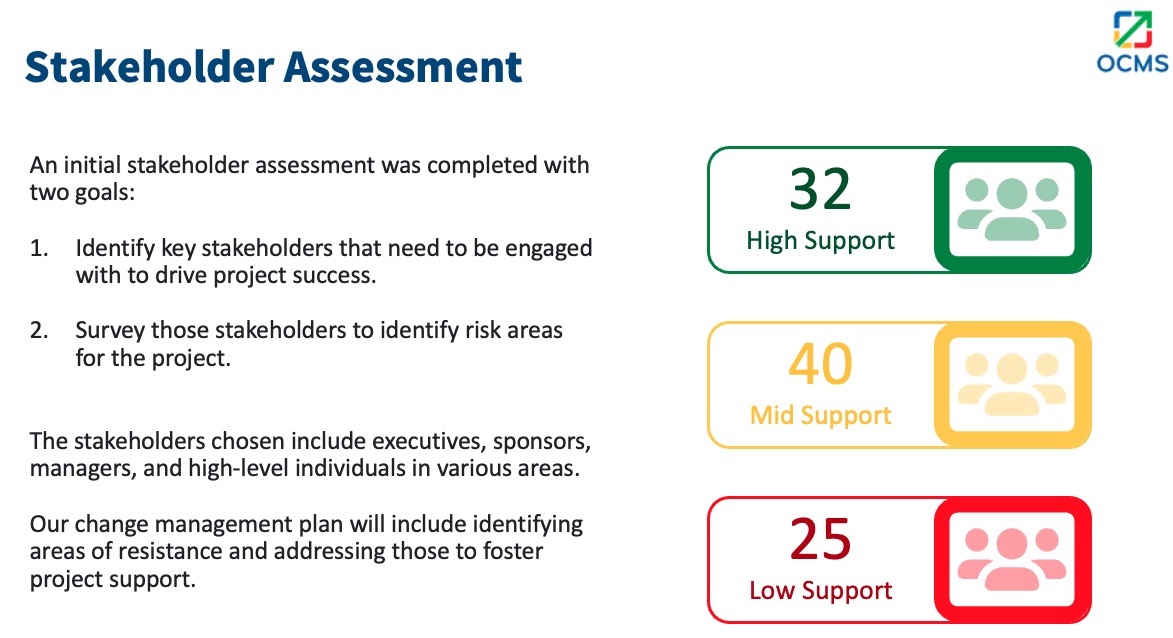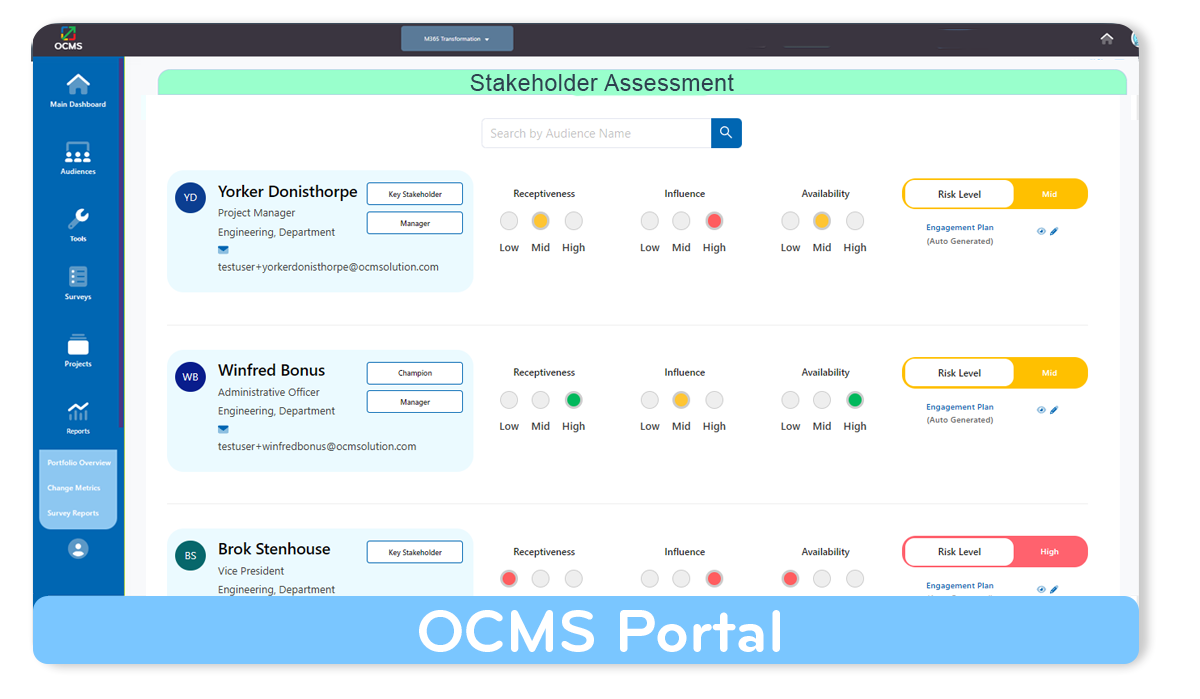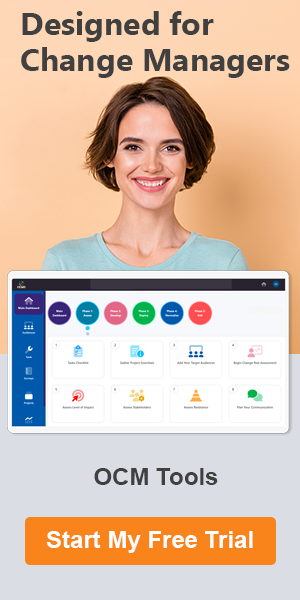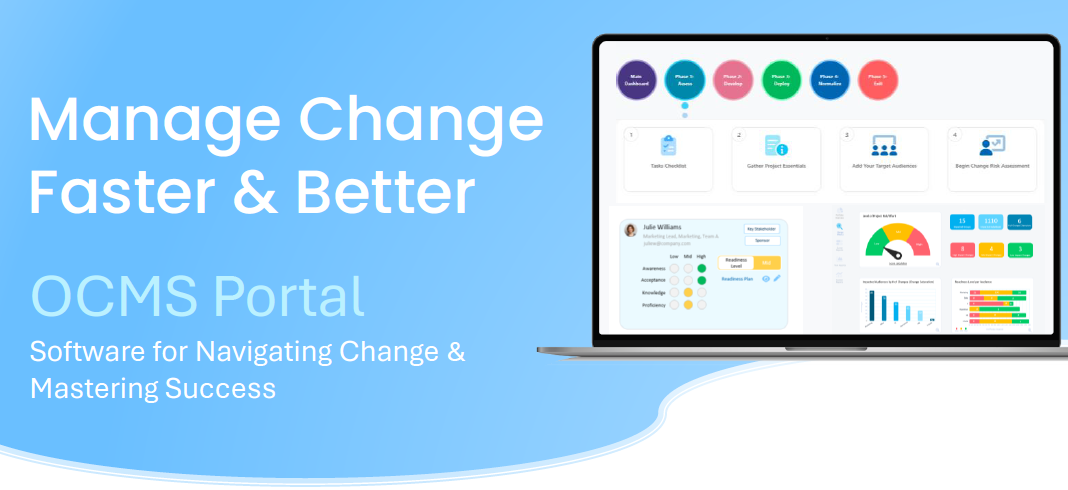What Is a Stakeholder Analysis & Why Is It Important?
Change management is a dynamic process. Project success often hinges on navigating a complex web of relationships. Stakeholders – individuals or groups impacted by or influencing your project – play a vital role in its outcome.
Understanding their needs, interests, and potential influence is paramount to navigating this landscape and ensuring a smooth journey toward project success.
This is where stakeholder analysis steps in, acting as a powerful tool to shed light on your project’s stakeholder ecosystem. But exactly what is the purpose of stakeholder analysis, and how can it be leveraged to maximize your project’s chances of success? We’ll dive into those answers in this article.
Watch a summary below:
Story Highlights
|
What is a Stakeholder Analysis?
Stakeholder analysis is a systematic process of identifying the various individuals and groups who have a stake in your project. It goes beyond simply creating a list of names. It delves deeper, assessing the level of influence each stakeholder wields and their potential impact on the project.
This analysis provides a comprehensive understanding of the stakeholder landscape, empowering you to develop targeted strategies for communication, engagement, and ultimately, project success.
Learn more: What is a stakeholder map & analysis?

Why Is Stakeholder Analysis Crucial?
It’s not unusual for those new to change management to wonder, “What is a stakeholder matrix?” and “What is the purpose of stakeholder analysis?” Once you understand why it’s an integral part of a project it will all make perfect sense.
Here are some compelling reasons why stakeholder analysis is a cornerstone of successful project management:
Enhanced Communication and Collaboration
Through stakeholder analysis, you gain a clear picture of who needs to be informed about the project expectations and how best to communicate with them. This allows you to tailor communication strategies to different stakeholders, ensuring everyone receives relevant information in a format they understand.
Reduced Risk of Project Failure
Proactive stakeholder management helps identify potential roadblocks early on. By understanding concerns and areas of resistance, you can develop mitigation strategies to address them before they derail your project.
Increased Project Buy-In
Stakeholder analysis allows you to identify key stakeholders whose support is crucial for project success. By engaging them early and throughout the project lifecycle, you can build trust, address concerns, and foster a sense of ownership, ultimately increasing buy-in for the project.
Do you have any questions about this article about “What is the stakeholder matrix?” and “What is stakeholder analysis in project management?” Please reach out and let us know.
Improved Resource Allocation
Stakeholder analysis helps you prioritize your resources effectively. By understanding stakeholder needs and potential impact, you can allocate resources strategically across impacted groups, ensuring efforts are directed toward the most critical areas.
Enhanced Project Delivery
A well-managed stakeholder ecosystem leads to smoother project execution. By keeping stakeholders informed, engaged, and aligned with project goals, you can minimize delays, mitigate risks, and ensure a more efficient delivery process.
Conducting an Effective Stakeholder Analysis
Now that we understand the answers to “What is a stakeholder matrix” and “What does stakeholder analysis enable project managers to do,” let’s delve into the steps involved in conducting one effectively.
Step 1: Identify Stakeholders
The first step is to create a comprehensive list of all individuals and groups who have a stake in your project. Consider internal stakeholders (project team members, management, executives) and external stakeholders (clients, vendors, regulatory bodies).
Step 2: Prioritize Stakeholders
Not all stakeholders carry the same weight. Prioritize stakeholders based on their level of influence and power over the project. Also, consider their level of interest in the project’s outcome. High-influence, high-interest stakeholders require more attention and targeted communication strategies.
Another metric to consider is the stakeholder’s availability. The less availability they have for meetings, workshops, or training, the higher their risk.
Step 3: Assess Stakeholder Needs and Expectations
Once you have identified and prioritized your stakeholders, delve deeper to understand their unique needs and expectations. Consider their concerns, potential support or resistance points, and preferred communication styles.
Step 4: Develop Stakeholder Engagement Strategies
Armed with the insights gathered from the previous steps, develop tailored strategies for engaging with each stakeholder group. This could involve communication plans, stakeholder meetings, or targeted presentations, ensuring everyone is kept informed and their needs are addressed.
Do you have questions or feedback about this article answering, “What is a stakeholder analysis in project management” and “What is the importance of stakeholder analysis?” Please reach out and let us know.
Stakeholder Analysis Tools and Techniques
Now that you’ve learned the answer to, “What is a stakeholder analysis,” you’ll next want to know the tools that can help you perform one.
There are several tools and techniques that can enhance your stakeholder analysis process:
- Stakeholder Power/Interest Matrix: What is the stakeholder matrix? This matrix categorizes stakeholders by their level of power/influence and receptiveness to the project, providing a visual representation of the stakeholder landscape.
- Stakeholder Interviews: Conducting one-on-one interviews with key stakeholders provides valuable insights into their needs, concerns, and expectations.
- Surveys: Online surveys can be a time-efficient way to gather information from a wider range of stakeholders. Using an online survey tool, like the one in the OCMS Portal, drives instant analytics reporting on stakeholder risk as the surveys are filled out.
- Change Management Software: Software solutions that offer features specifically designed to support stakeholder engagement and facilitate stakeholder assessment and management. OCMS Portal offers features like communication logs, surveys, and stakeholder engagement tools, while also providing tools for change impacts, readiness, training, and more.

Autogenerated Stakeholder Assessment from OCMS Portal.
The questions answered in this article, such as “What is the purpose of a stakeholder analysis?” and “What is a stakeholder map?” are common for those new to change management. Would you like to learn more about the change management process? Review our tutorials here.
Beyond the Basics: Continuous Stakeholder Engagement
Stakeholder analysis is not a one-time event. It’s an ongoing process that needs to be revisited throughout the project lifecycle.
Continuously monitor stakeholder needs and expectations, address any emerging concerns, and adapt communication strategies as needed. This consistent engagement ensures your project stays on track and delivers value to all stakeholders.
What Is a Stakeholder Analysis Benefit for Long-Term Success?
The benefits of stakeholder analysis extend far beyond the immediate project. By fostering positive relationships with stakeholders, you lay the groundwork for long-term success for future transformation initiatives.
Stakeholders who feel informed, valued, and heard are more likely to become champions for your project and future endeavors. This fosters trust, collaboration, and ultimately, a more positive and productive project environment.
Conclusion: Empowering Project Success Through Stakeholder Analysis
Stakeholder analysis is not a complex magic trick. But it is a powerful tool that, when wielded effectively, can significantly increase your chances of project success. By identifying stakeholders, understanding their needs, and developing targeted engagement strategies, you can navigate the intricate stakeholder landscape and steer your project toward a successful outcome.
When answering, “What is the purpose of stakeholder analysis?” remember, successful project management is not just about completing tasks and meeting deadlines. It’s about building relationships and ensuring everyone impacted by the project feels valued and contributes to its success.
Embrace stakeholder analysis as a cornerstone of your change management approach, and witness the positive ripple effect it creates, leading to more successful projects and a more collaborative and productive work environment.
Do you have anything to add to our article answering the questions “What is stakeholder analysis in project management?” and “What does stakeholder analysis enable project managers to do?” If so, please reach out and let us know.
OCMS Portal – OCM & Stakeholder Analysis Tools
The OCMS Portal’s Stakeholder Analysis Tool is one part of a comprehensive platform designed to streamline the process of identifying, categorizing, and managing stakeholders for various projects and initiatives.
This tool offers a user-friendly interface, customizable features, and facilitates collaboration among team members by providing a centralized space for sharing insights, updates, and strategies related to stakeholder engagement.
Learn more and sign up for a free trial today!
FAQ: What Is a Stakeholder Map & Analysis?
What is a stakeholder analysis?
Stakeholder analysis is a systematic process of identifying the various individuals and groups who have a stake in your project.
What is a stakeholder matrix?
The stakeholder matrix categorizes stakeholders by their level of power/influence and receptiveness to the project, providing a visual representation of the stakeholder risk landscape.
What is the purpose of a stakeholder analysis?
Through stakeholder analysis, you gain a clear picture of who needs to be informed about the project expectations and how best to communicate with them and enable them for success. Project risk is also reduced when you understand the stakeholders being impacted and their risk related to project adoption.
Note: Content on OCM Solution's ocmsolution.com website is protected by copyright. Should you have any questions or comments regarding this OCM Solutions page, please reach out to Ogbe Airiodion (Change Management Lead) or the OCM Solutions Team today. OCM Solution was previously known as Airiodion Global Services (AGS).
External Sources: stock.adobe.com





